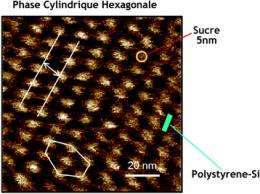New ultra-thin electronic films have greater capacity

(Phys.org) -- The development of a new combination of polymers associating sugars with oil-based macromolecules makes it possible to design ultra-thin films capable of self-organization with a 5-nanometer resolution. This opens up new horizons for increasing the capacity of hard discs and the speed of microprocessors. The result of a French-American collaboration spearheaded by the Centre de Recherches sur les Macromolécules Végétales (CNRS), this work has led to the filing of two patents. It is published in the journal ACS Nano. This new class of thin films based on hybrid copolymers could give rise to numerous applications in flexible electronics, in areas as diverse as nanolithography, biosensors and photovoltaic cells.
Before new generations of microprocessors can be devised, an evolution in lithography, the technique used for printing electronic circuits, is indispensable. Until now, the thin films used in electronic circuits have been designed from synthetic polymers exclusively derived from petroleum. However, these thin films have limitations: their minimum structural resolution is around 20 nanometers and cannot be reduced further by combining petroleum-derived polymers. This limit has been one of the main obstacles to the development of new generations of very-high-resolution flexible electronic devices.
Why was there such a limit? Because of the low incompatibility between the two blocks of polymers, both derived from oil. For that reason, the team headed by Redouane Borsali, CNRS senior researcher at the Centre de Recherches sur les Macromolécules Végétales (CERMAV), came up with a hybrid material: this new class of thin films combines sugar-based and petroleum-derived (silicon containing polystyrene) polymers with widely different physical/chemical characteristics. This copolymer, formed of highly incompatible elementary building blocks, is similar to an oil bubble attached to a small water bubble. The researchers have shown that this type of structure is capable of organizing itself into sugar cylinders within a petroleum-based polymer lattice, each structure having a size of 5 nanometers, i.e. much smaller than the resolution of “old” copolymers, exclusively composed of petroleum derivatives. In addition, this new generation of material is made from an abundant, renewable and biodegradable resource: sugar.
Achieving this performance makes it possible to envisage numerous applications in flexible electronics: miniaturization of circuit lithography, six-fold increase in information storage capacity (flash memories – USB keys – no longer limited to 1 Tbit of data but 6 Tbit), enhanced performance of photovoltaic cells, biosensors, etc. The researchers are now seeking to improve control of these nano-glycofilms' large-scale organization and design in different self-organized structures.
More information: Oligosaccharide/Silicon-Containing Block Copolymers with 5 nm Features for Lithographic Applications. Cushen, J.; et al.. ACS Nano, Published on the 24 April 2012.
Journal information: ACS Nano
Provided by CNRS

















